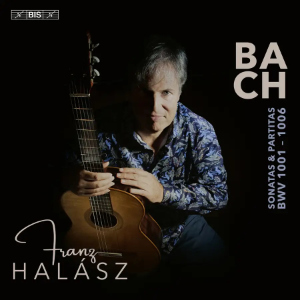
Johann Sebastian Bach (1685-1750)
Sonatas and Partitas, BWV 1001-1006
Franz Halász (guitar)
rec. 2022, Wallfahrtskirche Maria Himmelfahrt, Ising, Germany
BIS BIS2705 SACD [2 discs: 131]
The music on this recorded programme was composed in 1720, and published in 1802. It laid largely ignored until the great Hungarian violinist Joseph Joachim (1831-1907) started to give public performances of it. Subsequently, this music has been performed and recorded by almost every major violinist, some multiple times. The remarkable Russian-born American violinist, Johnny Gandelsman plays all three Partitas and Sonatas in a single concert, without intermission; it takes more than two hours.
Motivated by a dearth of quality music within the guitar repertory, key guitarists of the time turned to transcriptions and arrangements of quality music from other sources. Francisco Tárrega (1852-1907) was one of the very first guitarists to transcribe the music of J.S.Bach for the guitar. His efforts included the Bourrée from BWV 1002 and the Fugue from BWV 1001.
During the 1920s, Andrés Segovia focussed his attention on the Chaconne from BWV 1004. His transcription was published in 1934. It is obvious from his score that the transcription of this music by Busoni for piano, significantly influenced Segovia’s approach, although he never acknowledged that. His inaugural performance was in June 1935, in Paris, to great acclaim. His wife of the time, Paquita Madriguera, noted that whenever Segovia had to play this piece in concert, he was agitated during the preceding time. There is evidence to suggest that Segovia was not the first guitarist to play this music in public recital. That initiative goes to the blind guitarist Antonio Jiménez Manjón (1866-1919)
Franz Halász is an American-born German guitarist. His international career began with the winning of First Prize in the International Segovia Competition in Spain, and the Seo-Ohashi competition in Japan. Despite these successes, Halász is not a supporter of guitar competitions. He believes that in such an environment, one can lose the sense of being a musician. He has worked with major orchestras, is a prolific recording artist and performs as a duettist with his wife, pianist Debora Halász.
In reviewing the performances on this recording, there is temptation to go directly to the Chaconne from BWV 1004 (Disc 1, track 17); it’s akin to reading the last chapter of a book first, to quickly discover who ‘done it’. In a relatively short space of time we are able to learn much about the performer’s musicianship and technical facility. On this occasion, the first observation is the timing of the track {13:06]. This is not the fastest recording but compares with Segovia [13:55], Julian Bream [15:47], John Williams [14:07} and Ben Verdery [16:07].Violinist, Hilary Hahn takes 17:50 to perform this, Menuhin takes 14:25 and Ivry Gitlis 15:30.
Among many of today’s young musicians, single note passages requiring rapid execution, are embraced as an opportunity to display advanced technical facility, often to the detriment of the music. A quick review of recently-recorded versions of Vivaldi’s Four Seasons exemplifies this observation. Those single note passages notes of the Chaconne requiring rapid execution are sometimes treated similarly by both guitarists and violinists. Franz Halász is a fine guitarist, especially technically; however, his approach to these passages is redolent of Paco de Lucia’s picado in flamenco music. This same display occurs in all similar passages of the remaining music on this recording, and in this reviewer’s opinion, mars an otherwise exemplary overall performance. The arrangements of the music by Halász are well done, with embellishments often deviating from those in the Segovia text, and with logical reason.
The nature of the guitar invariably brings into question the tone and volume capability of the player.
In reality these are virtually impossible to ascertain from a recording. That said, on this occasion, both sound impressive. While Segovia was emphatic about the need for strong, flexible nails in producing good volume and agreeable tone, Halász uses all artificial finger nails. In Halász’s favour, the advancement in materials for synthetic nails has progressed significantly since the time of Segovia. They are used by many concert artists, both as an emergency measure, and in total preference by others less endowed with Segovia’s ideal.
The other factor affecting these parameters is the actual quality of the instrument. In his recording Spain (BIS 2565), Halász used an instrument by Matthias Damman (2019). This luthier is renowned for innovation in modern design including bracing and double tops. In the present recording, a traditional instrument by Herman Hauser (1936) is employed. This is rather a chalk-and-cheese situation. Many prosecute the case that while some modern innovations produce larger volume, it is at the expense of tone and musicality. Halász has his reasons, and the results are comparatively impressive.
Overall, this is a fine rendition of the repertory, marred only by virtuosic display at the expense of the music. Halász is not alone in this, a propensity of many young musicians in a highly competitive environment
The two discs of this music are in discrete sealed envelopes within the cover of the presentation. This prevents scratching of the two discs against each other Once opened they are challenging to replace, and induce an annoying bulge in the cover. The general presentation is pleasing, but is no substitute for the appropriate jewel case.
Zane Turner
If you purchase this recording using a link below, it generates revenue for MWI and helps us maintain free access to the site



















